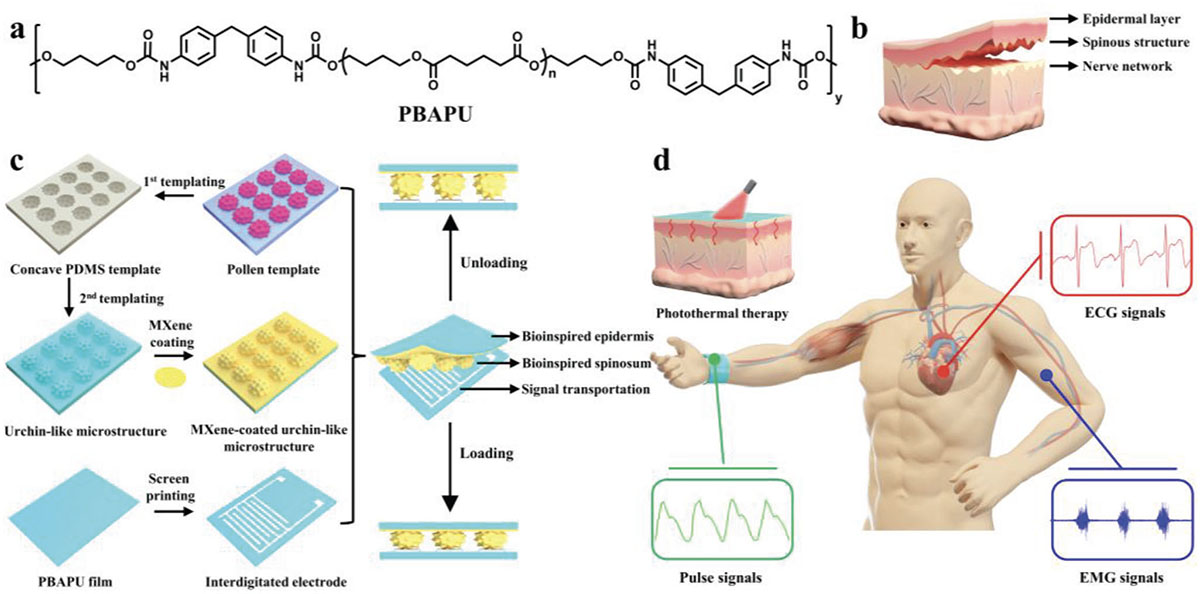| Aug 31, 2023 | |
Bioinspired electronic skin mimics and enhances human sensory capabilities |
|
| (Nanowerk Spotlight) Wearable electronic sensors have garnered great interest in recent years for their potential to revolutionize health monitoring and medical care. Through flexible patches applied to the skin, these devices could track vital signs, motion, and muscle activity during everyday life. This around-the-clock data could provide early diagnosis of emerging conditions and prompt preventative treatment. | |
| However, current sensors face major challenges in achieving the combination of high sensitivity, fast response time, low detection limits, and long-term stability needed for medical-grade performance. | |
| In a new study published in Advanced Functional Materials ("A Skin-Bioinspired Urchin-Like Microstructure-Contained Photothermal-Therapy Flexible Electronics for Ultrasensitive Human-Interactive Sensing"), researchers leverage the intricate sensory system of human skin, which consists of various layers and receptors crucial for tactile perception, to enhance the sensor's capabilities. | |
| They specifically focus on the skin's spinosum microstructure found in the epidermis and dermis, structures essential for magnifying sensory signals and transmitting them to mechanoreceptors. | |
| Inspired by the way these microscopic structures in human skin concentrate pressure and expand the sensing area to amplify tactile signals, the team employed a template based on the thorny surface of chrysanthemum pollen grains. They created a flexible polymer skin containing urchin-like bumps and coated these protrusions with nanometer-thin, electrically conductive sheets, endowing the material with exceptional pressure response and sensitivity. | |
 |
|
| a) Molecular structure of PBAPU elastomer. b) Schematic of the skin structure. c) Schematic of the fabrication of a skin bionic flexible electronic sensor from the assembly of the PBAPU elastomer matrix with conducting MXene nanosheets-coated urchin-like microstructures templated from natural chrysanthemum pollen grains microstructures, and an interdigitated electrode-coated PBAPU elastomer substrate for d) wearable healthcare medical sensing and photothermal therapy. (click on image to enlarge) (Reprinted with permission from Wiley-VCH Verlag) | |
| The new approach provides a promising solution by combining the unique properties of MXene, a 2D nanomaterial, with a novel elastomer matrix inspired by the microstructure of human skin. Using this material to coat synthetic skin-like microstructures helps concentrate applied pressures and expand the electrical sensing area. | |
| The sensor employs MXene nanosheets to achieve these exceptional performance metrics. MXene is known for its electrical conductivity, hydrophilicity, mechanical properties, and photothermal performance. When MXene nanosheets are integrated into the elastomer matrix, they substantially enhance the sensor's electrical conductivity and other essential attributes. The resulting device exhibited performance rivaling or exceeding human skin, responding rapidly to tiny pressures with sensitivity down to 0.12 Pascals. | |
| The study also addresses the mechanical mismatch between conventional elastomers used in sensors and human skin. Most elastomers have mechanical properties that are not fully compatible with human skin, leading to poor wearing comfort and fluctuations in sensing performance. | |
| The researchers tackled this problem by creating a new elastomer called PBAPU. Formulated from polybutylene adipate, 4,4-diphenylmethane diisocyanate, and 1,4-butanediol, PBAPU has an elastic modulus closely matching that of human skin, offering high tensile strength and stretchability. This ensures a better fit, enhanced comfort, and more reliable data collection when the sensor is worn. | |
| Testing showed the sensor could detect a wide range of stimuli representing physiological signals or environmental pressures. It successfully monitored wrist pulse, throat movements, finger tapping in Morse code, and bicycle tire inflation. Integrated into an artificial skin patch, the sensor array could also spatially map pressure points from physical touch. | |
| Importantly, the flexible electronic skin could measure subtle muscle contractions via electromyography signals, as well as record electrocardiogram data for cardiac monitoring. Its performance matched or exceeded medical electrodes, despite having a simpler adhesive-free application. This could enable continuous health tracking during exercise and other active lifestyles. | |
| In addition to its diagnostic abilities, the electronic skin provides therapeutic functionality. The conductive nanosheet coating converts near-infrared light into heat. Irradiating a skin patch attached to the wrist generated localized warming that improved joint flexibility and reduced arthritis pain. The effects were monitored in real time via the sensor’s pressure measurements. | |
| This photothermal heating can reach therapeutic temperatures rapidly, within about a minute of light exposure. It also allows precise control of the heat level by tuning the light. The researchers demonstrated that the patch reliably underwent repeated heating cycles without degradation. | |
| Integrating therapy and monitoring in one wearable device provides an innovative approach to personalized health management. Users could receive diagnosis prompting specific treatment, as well as direct feedback confirming therapeutic effects. By merging complementary technologies, flexible electronics may open up new possibilities for continuous care. | |
| This work presents an early-stage proof of concept for this dual diagnostics and therapy technology. More research is needed to evaluate its performance and safety through clinical studies. If the approach proves successful, it could enable a new generation of smart wearable health aids that go beyond passive tracking to take a more active role in maintaining wellbeing. | |
 By
Michael
Berger
– Michael is author of three books by the Royal Society of Chemistry:
Nano-Society: Pushing the Boundaries of Technology,
Nanotechnology: The Future is Tiny, and
Nanoengineering: The Skills and Tools Making Technology Invisible
Copyright ©
Nanowerk LLC
By
Michael
Berger
– Michael is author of three books by the Royal Society of Chemistry:
Nano-Society: Pushing the Boundaries of Technology,
Nanotechnology: The Future is Tiny, and
Nanoengineering: The Skills and Tools Making Technology Invisible
Copyright ©
Nanowerk LLC
|
|
|
Become a Spotlight guest author! Join our large and growing group of guest contributors. Have you just published a scientific paper or have other exciting developments to share with the nanotechnology community? Here is how to publish on nanowerk.com. |
|
